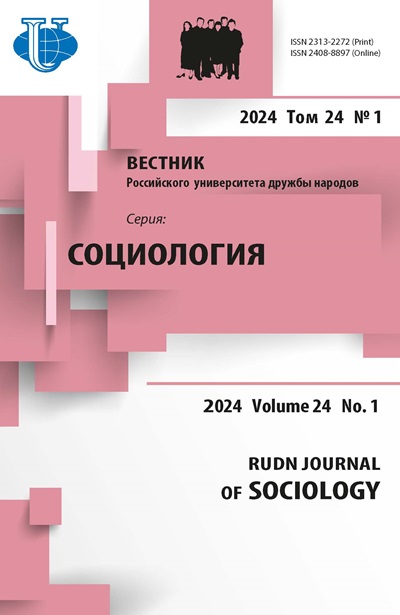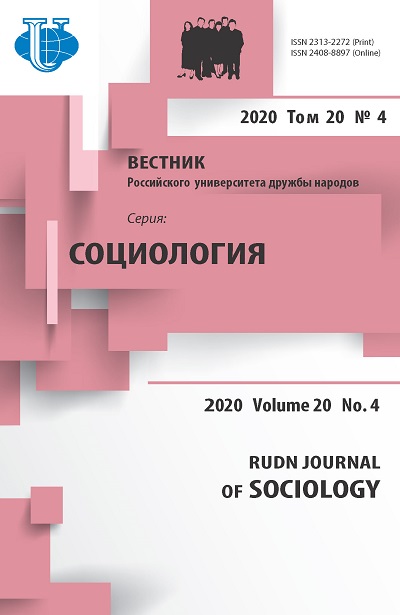Dynasties and brand names in the political sphere of the post-industrial society
- Authors: Barkov S.A.1, Dorokhina O.V.2, Markeeva A.V.1, Maximov A.A.1
-
Affiliations:
- Lomonosov Moscow State University
- Russian Presidential Academy of National Economy and Public Administration
- Issue: Vol 20, No 4 (2020)
- Pages: 801-820
- Section: Contemporary society: the urgent issues and prospects for development
- URL: https://journals.rudn.ru/sociology/article/view/25212
- DOI: https://doi.org/10.22363/2313-2272-2020-20-4-801-820
Cite item
Full Text
Abstract
During the formation of contemporary democracy, its ideologists strived to create a management mechanism that did not resemble monarchy at all, so that to emphasize the radical nature of social-political changes in the transition from pre-industrial to industrial society. The dynastic transfer of power in all its manifestations and at all levels of governance was denounced as outdated, ineffective, and violating the very foundations of the people’s will. The article shows that, despite the initial criticism, dynasties are widespread in contemporary politics. The family is a part of politics and systems of public administration in a truly post-industrial form - as a brand, image, and symbol. The transition to the post-industrial society predetermines a change in the attitude to dynasties and their role not only in politics but also in systems of interaction with the population (electorate). Based on the analysis of other research and authors’ data on political dynasties at different levels of government in 17 countries, the article proves the changing attitude to political dynasties even within democratic systems. Political dynasties increasingly often contribute to the creation and expansion of social networks, establishing sustainable political ties, ensuring gender presentation in government, etc. There are numerous manifestations of dynasties in countries with different levels of social-economic development (developed and developing) and different types of government (authoritarian and democratic) due to the application of marketing thinking and technologies in politics. Dynasties allow to effectively use the family potential to create and promote political brands, to ensure sustainable social choices of political candidates and parties, to facilitate political socialization of new generations and relative predictability of politicians’ behavior, who would follow a ‘family line’ in making important decisions.
About the authors
S. A. Barkov
Lomonosov Moscow State University
Author for correspondence.
Email: barkserg@live.ru
доктор социологических наук, заведующий кафедрой экономической социологии и менеджмента
Leninskie Gory, 1-33, Moscow, 119234, RussiaO. V. Dorokhina
Russian Presidential Academy of National Economy and Public Administration
Email: odorokhina@yandex.ru
кандидат cоциологических наук, доцент кафедры управления проектами и программами Института государственной службы и управления
Prosp. Vernadskogo, 82, Moscow, 119571, RussiaA. V. Markeeva
Lomonosov Moscow State University
Email: arsenii.maksimov@mail.ru
кандидат социологических наук, доцент кафедры экономической социологии и менеджмента
Leninskie Gory, 1-33, Moscow, 119234, RussiaA. A. Maximov
Lomonosov Moscow State University
Email: anna_markeeva@mail.ru
кандидат социологических наук, старший преподаватель кафедры экономической социологии и менеджмента
Leninskie Gory, 1-33, Moscow, 119234, RussiaReferences
- Barkov S.A., Dorokhina O.V. Semeystvennost kak sotsialno-upravlencheskaya kategoriya: istorichesky aspect [Familiality as a social-management category: A historical aspect]. Sociologiya. 2010; 3 (In Russ.).
- Gaman-Golutvina O.V. Metafizika elitnykh transformatsiy v Rossii [Metaphysics of elite transformations in Russia]. Political Studies. 2012; 4 (In Russ.).
- Kolesnikova E.M. Inzhenernye dinastii i perspektivy professionalnoy biografii studentov inzhenernykh vuzov [Engineering dynasties and prospects of professional biography for students of engineering universities]. Sotsiologichesky Zhurnal. 2018; 24 (1) (In Russ.).
- Kryshtanovskaya O.V. Anatomiya rossiiskoi elity [Anatomy of the Russian Elite]. Moscow; 2005 (In Russ.).
- Michels R. Demokraticheskaya aristokratiya i aristokraticheskaya demokratiya [Democratic aristocracy and aristocratic democracy]. Sotsiologicheskie Issledovaniya. 2000; 1 (In Russ.).
- Posukhova O. Professionalnaya dinastiya kak rezultat semeynykh strategiy: inertsiya ili preemstvennost [Professional dynasty as a result of family strategies: Inertia or continuity]. Vlast. 2013; 12 (In Russ.).
- Tkach O. Zavodskie dinastii v sovremennykh rynochnykh usloviyakh [Factory dynasties in the contemporary market conditions]. Chelovek i Trud. 2007; 12 (In Russ.).
- Toshchenko Zh.T. Elita? Klany? Kliki? Kak nazvat tekh, kto nami pravit? [Elite? Clans? Clicks? What is the names of those who rule?]. Sotsiologicheskie Issledovaniya. 1999; 11 (In Russ.).
- Trotsky L. Predannaya revolyutsiya. Chto takoe SSSR i kuda on idet [Devoted Revolution. What is the USSR and Where it Goes]. Moscow; 1991 (In Russ.).
- Shamaninin N.V., Lapshin V.E. Osobennosti professionalnogo samoopredeleniya v razlichnykh tipakh semey (na materiale dinastiy) [Features of professional self-identification in different types of families (on the example of dynasties)]. Vestnik KGU. Seriya: Pedagogika. Psikhologiya. Sotsiokinetika. 2019; 2 (In Russ.).
- Shkaratan O.I. Rossiyskaya “psevdoelita” i ee identifikatsiya v mirovom i natsionalnom kontekstakh [Russian ‘pseudo-elite’ and its identification in the global and national context]. Mir Rossii. 2011; 4 (In Russ.).
- Aaker D. Managing Brand Equity. New York; 1991.
- Balanquit R.T., Lianca P.C., Yambao J.Y. Measuring political dynasties in Metro Manila. Philippine Review of Economics. 2017; LIV (1).
- Bennett W.L., Lagos T. Logo logic: The ups and downs of branded political communication. Annals of the American Academy of Political and Social Science. 2007; 611.
- Clubok A.B., Wilensky N.M., Berghorn F.J. Family relationships, congressional recruitment, and political modernization. Journal of Politics. 1969; 31 (4).
- Dal Bo E., Dal Bo N.P., Snyder J. Political dynasties. Review of Economic Studies. 2009; 76.
- Farber B. Kinship and Class: A Midwestern Study. New York; 1971.
- Felman S. Jacques Lacan and the Adventure of Insight: Psychoanalysis in Contemporary Culture. Cambridge; 1987.
- Fiva J.H., Smith D.M. Political dynasties and the incumbency advantage in party-centered environments. American Political Science Review. 2018; 112 (3).
- Folke O., Persson T., Rickne J. Dynastic political rents? Economic benefits to relatives of top politicians. Economic Journal. 2017; 127.
- Geys B., Smith D.M. Political dynasties in democracies: Causes, consequences and remaining. Economic Journal. 2017; 127.
- Global Intangible Finance Tracker. Report 2019. URL: https://brandfinance.com/images/upload/gift_2.pdf.
- Hennenberg S., Scammell М., Shaughnessy N.J. Political marketing management and theories of democracy. Marketing Theory. 2009; 9.
- Hess S. America’s Political Dynasties: From Adams to Kennedy. New York; 1966.
- Ishibashi M., Reed S.R. Second-generation diet members and democracy in Japan: Hereditary seats. Asian Survey. 1992; 32 (4).
- Jalalzai F. Shattered, Cracked, or Firmly Intact? Women and the Executive Glass Ceiling Worldwide. New York; 2013.
- Kearney R.N. The mentor in the commencement of a political career: The case of Subhas Chandra Bose and C.R. Das. Journal of Political and Military Sociology. 1984; 12.
- Kellerman B. Mentoring in political life: The case of Willy Brand. American Political Science Review. 1978; 72.
- Kincaid D.D. Over his dead body: A positive perspective on widows in the US Congress. Western Political Quarterly. 1978; 31 (1).
- Kotler P., Keller R. Marketing Management. Pearson Education Limited; 2016.
- Kotler P. Overview of political candidate marketing. Advances in Consumer Research. 1975; 2.
- Kotler P., Levy S. Broadening the concept of marketing. Journal of Marketing.1969; 33.
- Kurtz II Donn M. The political family: A contemporary view. Sociological Perspectives. 1989; 32 (3).
- Laband D.N., Lentz B.F. Favorite sons: Intergenerational wealth transfers among politicians. Economic Inquiry. 1985; 23.
- Laband D.N., Lentz B.F. Like father, like son: Toward an economic theory of occupational following. Southern Economic Journal. 1983; 50 (2).
- Labonne J., Parsa S., Querubin P. Political Dynasties, Term Limits and Female Political Empowerment: Evidence from the Philippines. New York; 2016.
- Lahut J. There are two Ben Hansons running for seats in North Dakota’s Legislature, and they look nearly identical. 21.05.2020. URL: https://www.businessinsider.com/north-dakota-state-rep-ben-hanson-candidates-share-name-and-looks-2020-5.
- Levinson D.J. The Seasons of a Man’s Life. New York; 1978.
- Mendoza R.U., Beja E.L.Jr., Venidab V.S., Yapa D.B. Political dynasties and poverty: Measurement and evidence of linkages in the Philippines. Oxford Development Studies. 2016; 44 (2).
- Mills C.W. The Power Elite. New York; 1959.
- Moore S.W., Lace J., Wagner K.A. The Child’s Political World: A Longitudinal Perspective. New York; 1985.
- Parker G.R. Congress and the Rent-Seeking Society. Ann Arbor; 1996.
- Prewitt K. The Recruitment of Political Leaders: A Study of Citizen Politicians. Indianapolis; 1970.
- Querubin P. Families and politics: Dynastic persistence in the Philippines. Quarterly Journal of Political Science. 2016; 11 (2).
- Robertson-Snape F. Corruption, collusion and nepotism in Indonesia. Third World Quality. 1999; 20 (3).
- Rossi M.A. Self-perpetuation of political power. Economic Journal. 2017; 127.
- Scammell М. Political brands and consumer Citizens: The rebranding of Tony Blair source. Annals of the American Academy of Political and Social Science. 2007; 611.
- Shlapentokh V., Woods J. Feudal America. Personal Relations in American Politics and Business: A Feudal Phenomenon Elements of the Middle Ages in Contemporary Society. Pennsylvania State University; 2011.
- Van Coppenolle B. Political dynasties in the UK House of Commons: The null effect of narrow electoral selection. Legislative Studies Quarterly. 2017; 42 (3).
- Zavattaro S.M. Brand Obama: The implications of a branded president. Administrative Theory & Praxis. 2010; 32 (1).














